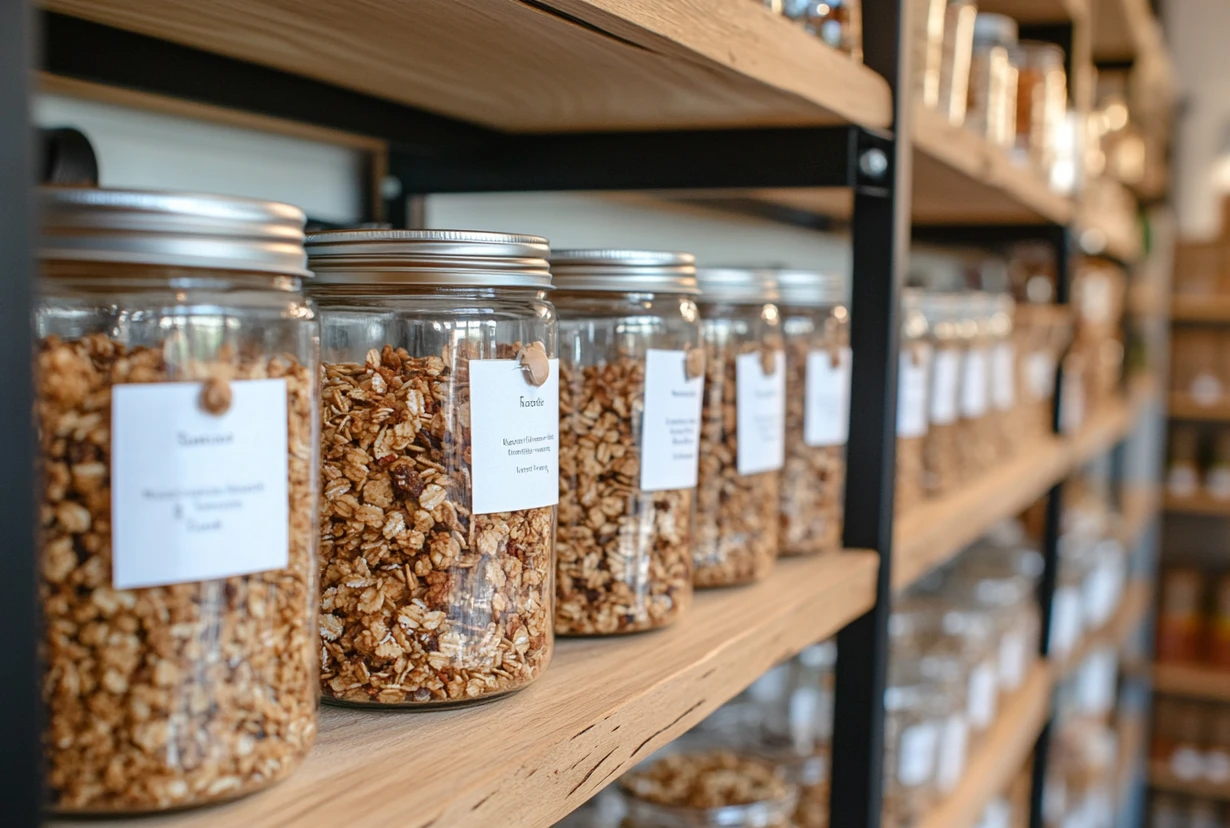There’s nothing more satisfying than creating your own batch of fresh homemade granola, filled with your favorite ingredients and baked to golden perfection. The combination of crunchy oats, sweet honey, and a mix of nuts and dried fruits makes for a delicious and healthy snack or breakfast option. But after putting in all that effort, how do you store fresh homemade granola to ensure it stays as fresh and crunchy as the day you made it?
Granola is a delicious and versatile snack that’s perfect for breakfast, on-the-go munching, or topping your favorite desserts. Making fresh homemade granola allows you to control the ingredients, ensuring a healthier and more flavorful treat. However, improper storage can quickly turn your crunchy masterpiece into a soggy or stale disappointment. Understanding how to store fresh homemade granola is essential for preserving its texture, flavor, and nutritional value. In this guide, we’ll explore expert tips and techniques to keep your granola fresh and crunchy for weeks.
How to Store Fresh Homemade Granola
Proper storage is the secret to maintaining the crunch and flavor of your homemade granola. Let’s dive into the best practices for keeping your granola fresh, starting with the type of container you use.
1. Choose the Right Container
a. Why Airtight Jars Are Ideal
Airtight containers are essential for storing granola because they keep out air and moisture, the two main culprits of staleness. When exposed to air, granola can lose its crisp texture and vibrant flavors. Invest in quality glass or BPA-free plastic jars with tight seals to extend the shelf life of your granola.
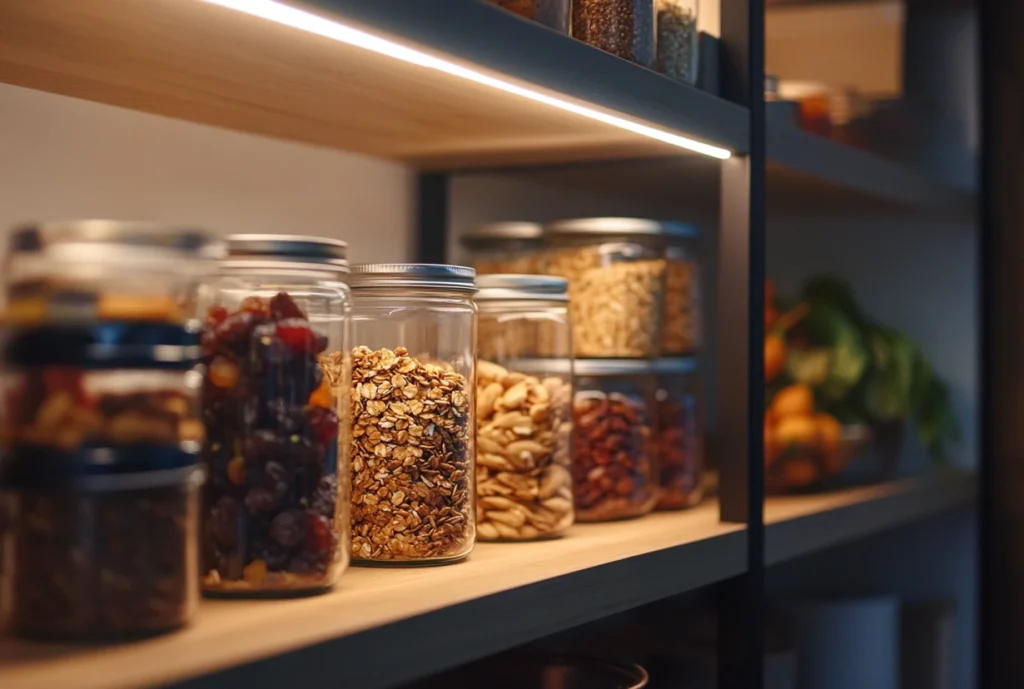
b. Benefits of Glass vs. Plastic
Glass jars are often preferred for granola storage due to their non-porous surface, which doesn’t retain odors or flavors from previous uses. Plastic containers are lightweight and more affordable, but ensure they’re food-grade and free from harmful chemicals. Whichever option you choose, make sure the lid fits snugly to maintain freshness.
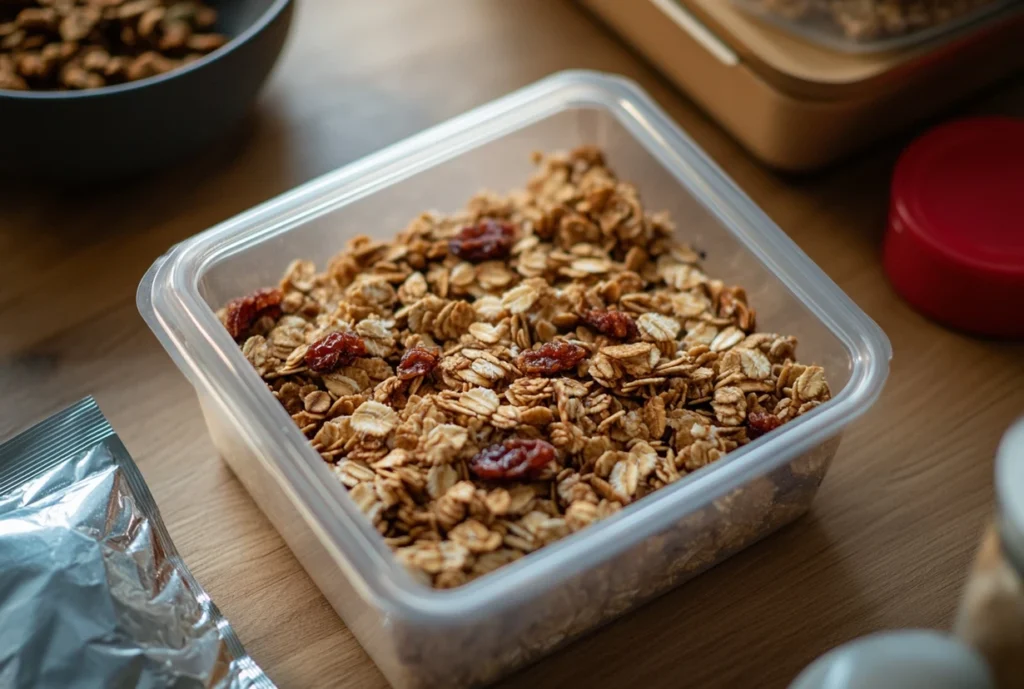
2. Store in a Cool, Dry Place
a. Avoid Sunlight Exposure
Direct sunlight can degrade the quality of your granola by causing oils to turn rancid and ingredients to lose their natural flavors. Keep your granola stored in a pantry or cabinet away from windows or heat sources.
b. Ideal Temperature for Granola Storage
Room temperature, ideally between 60°F and 75°F (15°C to 24°C), is perfect for granola storage. Extreme heat or humidity can negatively impact its texture and taste, so avoid placing it near ovens, stoves, or other warm areas.
3. Refrigeration: Pros and Cons
While granola is typically stored at room temperature, refrigeration can be an option in certain situations. Understanding when and how to refrigerate granola is key to maintaining its texture and flavor.
a. When to Refrigerate Granola
If your granola contains ingredients like fresh fruit or chocolate that may melt or spoil at room temperature, refrigeration is a smart choice. Additionally, in humid climates where moisture can seep into storage containers, refrigeration can help prevent sogginess.
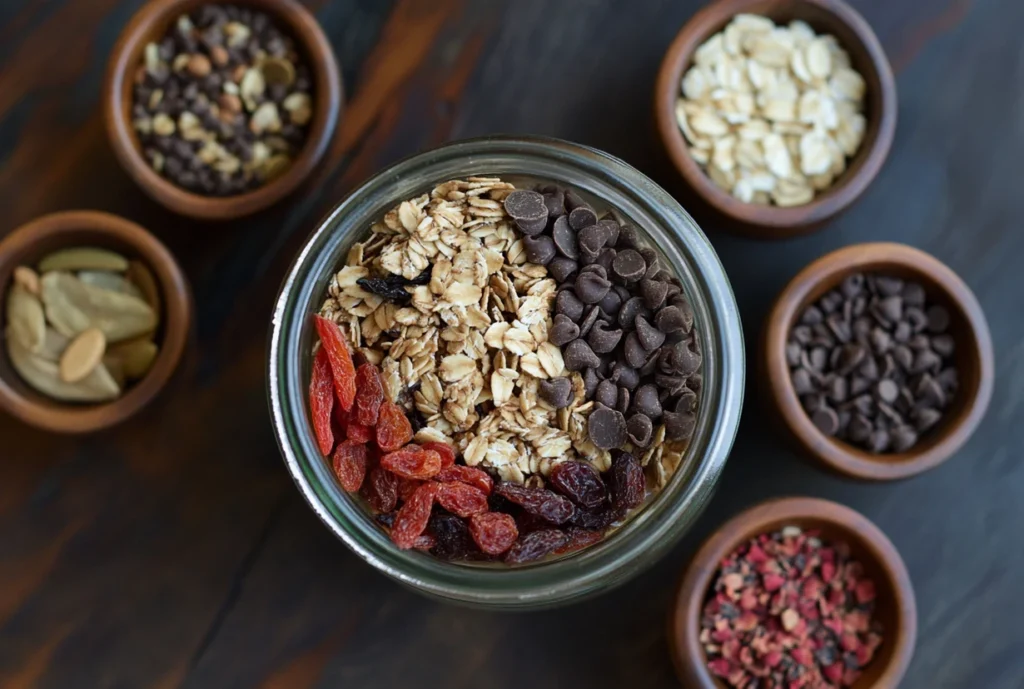
b. How Refrigeration Affects Texture
Refrigeration can extend the shelf life of granola, but it might affect its crunchiness. To avoid this, ensure the granola is stored in an airtight container and placed on a dry shelf inside the fridge. If you find the granola slightly softer after refrigeration, you can re-crisp it in the oven at a low temperature for a few minutes.
4. Freezing Granola for Long-Term Freshness
If you’ve made a large batch of granola, freezing is an excellent option for long-term storage. It preserves freshness and prevents spoilage while maintaining the crunch and flavor.
a. Proper Freezing Techniques
To freeze granola effectively, divide it into portions and place them in resealable freezer bags or freezer-safe containers. Squeeze out as much air as possible before sealing to avoid freezer burn. Label the containers with the date so you can track freshness.
b. Thawing Granola Without Losing Crunch
When you’re ready to enjoy frozen granola, remove the desired portion from the freezer and let it thaw at room temperature for about 15–30 minutes. Avoid microwaving, as this can cause the granola to become chewy or lose its crisp texture.
5. Avoiding Moisture Contamination
Moisture is the enemy of crunchy granola. Even a small amount can turn your perfectly crisp snack into a soggy disappointment. Here’s how to keep moisture at bay.
a. The Role of Silica Gel Packs
Silica gel packs are a clever addition to granola storage, especially in humid environments. These small, food-safe packets absorb excess moisture and help maintain the granola’s crunch. Place one inside the container (but ensure it doesn’t come into contact with the granola) for added protection.
b. How to Prevent Granola from Becoming Soggy
Always allow granola to cool completely before storing it. Trapping warm granola in a sealed container can create condensation, leading to sogginess. Additionally, avoid opening the container in steamy kitchens or during rainy weather, as this can introduce moisture.
6. Labeling and Rotating Your Granola
To avoid waste and ensure you always enjoy fresh granola, adopt a simple labeling and rotation system.
a. Importance of Dates
Label your granola container with the date it was made. Homemade granola typically stays fresh for 2–4 weeks when stored correctly, so keeping track of dates ensures you enjoy it at its peak.
b. Rotating Stock for Maximum Freshness
If you regularly make granola, use the “first in, first out” method. Place older granola containers at the front of your pantry or fridge and newer ones at the back. This habit prevents older batches from being forgotten and going stale.
7. Storing Flavored or Specialty Granola
Flavored or specialty granola with added ingredients like dried fruits, chocolate, or spices requires special attention during storage to maintain its taste and texture.
a. Handling Granola with Dried Fruits or Chocolate
Dried fruits can introduce extra moisture into granola, while chocolate can melt if stored improperly. To prevent these issues:
- Store this type of granola in smaller portions to minimize the impact of moisture.
- Use a cool, dry storage location or consider refrigeration for granola with chocolate.
- For granola with dried fruits, ensure the fruits are completely dry before mixing them in.
b. Managing Aromas and Flavors
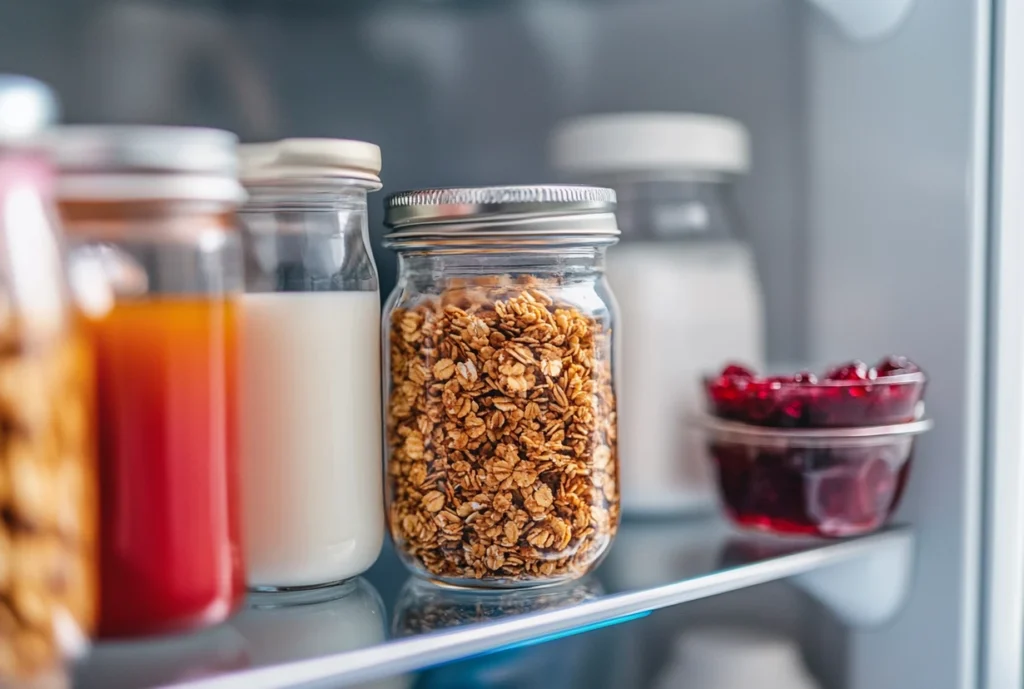
Granola can absorb strong odors from nearby foods, especially if stored in the refrigerator or freezer. To avoid this:
- Keep granola in an odor-proof, airtight container.
- Store it away from pungent items like spices, onions, or garlic.
| Special Ingredient | Storage Tip | Reason |
|---|---|---|
| Dried Fruits | Ensure dryness before storage | Prevents moisture contamination |
| Chocolate | Store in a cool, stable temperature | Avoids melting and clumping |
| Spices or Herbs | Use separate storage containers | Maintains original granola flavor without mixing with strong aromas |
Common Mistakes to Avoid When You Store Fresh Homemade Granola
Even with the best intentions, some common errors can compromise the freshness and quality of your granola. Let’s explore these pitfalls and how to avoid them.
a. Using Non-Airtight Containers
One of the biggest mistakes is storing granola in containers that aren’t airtight. Without a proper seal, air and moisture can sneak in, leaving your granola stale and soggy. Always ensure you store fresh homemade granola in high-quality, airtight jars or containers to keep it crisp and flavorful.
b. Overlooking Proper Cleaning Before Storage
Storing granola in a container that hasn’t been thoroughly cleaned can introduce unwanted odors, flavors, or even bacteria. Before you store fresh homemade granola, wash and dry the container completely to provide a clean, safe environment for your granola.
c. Forgetting to Cool Granola Before Storing
Warm granola can create condensation inside a sealed container, leading to moisture buildup and a loss of crunch. Always let your granola cool to room temperature before transferring it to a storage container.
d. Storing Near Heat or Sunlight
Heat and sunlight can speed up the spoilage of granola, especially if it contains oils or nuts. Place your containers in a cool, dark place to effectively store fresh homemade granola and extend its shelf life.
Pro Tip:
If you want your granola to taste as fresh as the day you made it, consider dividing it into smaller portions. This way, each batch you open will remain untouched and fresh for longer.
FAQs on How to Store Fresh Homemade Granola
To help you master the art of storing granola, here are some frequently asked questions about how to store fresh homemade granola effectively.
Q1: How long can I store fresh homemade granola at room temperature?
You can store fresh homemade granola at room temperature for up to 2–4 weeks if it’s kept in an airtight container and in a cool, dry place. Always check for any changes in texture or smell before consuming it.
Q2: Can I freeze granola without affecting its quality?
Yes, freezing is an excellent way to extend the shelf life of granola. Use freezer-safe bags or containers, and ensure they’re sealed tightly. Frozen granola can last up to 3 months and retains its crunch when thawed properly.
Q3: What’s the best way to store fresh homemade granola with chocolate chips?
Store granola with chocolate chips in a cool, dry place to prevent the chocolate from melting. In warmer climates, refrigeration may be a better option, but ensure it’s in an airtight container to avoid absorbing moisture.
Q4: How can I prevent granola from absorbing odors in the refrigerator?
To prevent granola from absorbing strong odors, always use an odor-proof, airtight container. Store it away from foods with strong smells like garlic, onions, or spices.
Q5: Can I add fresh fruit to my granola before storing it?
It’s best to avoid adding fresh fruit before storage as it introduces moisture, which can make the granola soggy and reduce its shelf life. Add fresh fruit right before serving for the best results.
Q6: How can I restore crunchiness to stale granola?
If your granola has lost its crunch, spread it on a baking sheet and heat it in the oven at 300°F (150°C) for 5–10 minutes. Let it cool completely before storing it again.
Keep Your Granola Fresh and Flavorful
Storing your fresh homemade granola properly is essential to maintain its delightful crunch and rich flavors. By following the tips outlined in this guide—such as using airtight containers, keeping it in a cool, dry place, and considering refrigeration or freezing when appropriate—you can extend the shelf life of your granola and enjoy it at its best.
For a delicious granola recipe to try at home, consider the Maple and Pecan Granola Recipe. This recipe combines the natural sweetness of maple syrup with the rich, nutty flavor of pecans, creating a granola that’s not only delicious but also perfect for any time of day.

